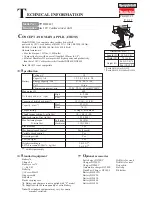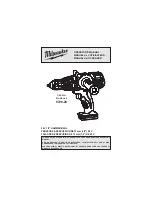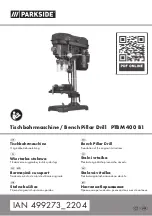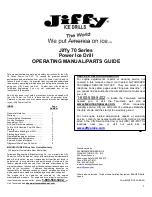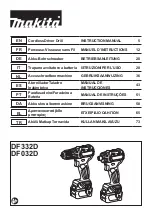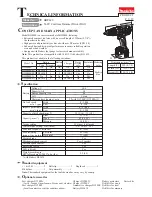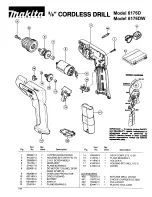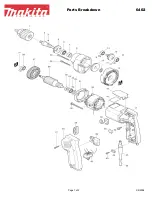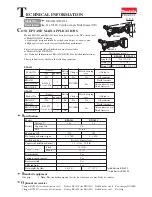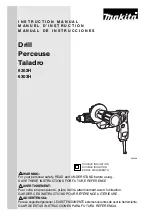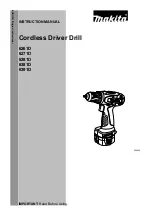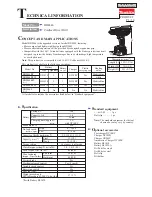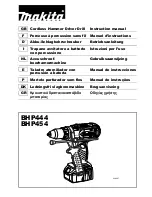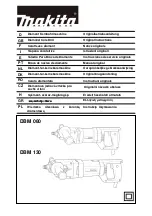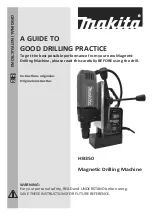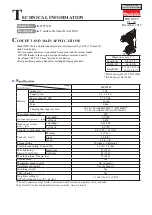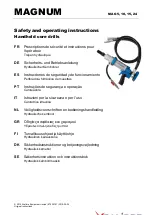
- 8 -
STARTING AND STOPPING
!
IMPORTANT! Before starting the electrical tool it is compulsory to wear protection
goggles, gloves and headphones (not provided).
!
IMPORTANT! Make sure nobody is approaching the working area while the tool
is running.
Starting
1) Insert the charged battery in the drill.
2) Position the rotation direction switch
(Fig. A pos.2)
in one of the two operating posi-
tions
(not in the centre).
3) Firmly grasp the hand grip
(Fig. A pos.8)
in your hand.
4) To start press the button
(Fig. A pos.1)
.
The switch is a ‘maintained action’ switch so the electrical tool will stay on when you
keep the switch pressed.
Stopping
To stop the drill release the switch
(Fig. A pos.1)
.
If you notice any working defects, switch off the electrical tool and consult the chapter
“Problems, causes and solutions”.
When not using the tool, turn it off.
OPERATIONAL TIPS
After reading the previous chapters carefully, apply these tips scrupulously to obtain
maximum performance.
Proceed calmly so as to become familiar with all the controls; after having gained sufficient
experience you will be able to make full use of its potential.
ELECTRONIC CHUCK SPEED ADJUSTMENT
Press the switch
(Fig. A pos.1)
gradually until the desired speed is reached. With less
pressure low speeds are obtained, whereas with more pressure high speeds are obtained.
CHUCK ROTATION DIRECTION REGULATION (fig. C)
IMPORTANT! The rotation direction inversion operation must be performed with the
tool off and the chuck stationary.
For drilling operations and tightening right thread screws (clockwise), move the rotation
direction switch
(Fig. A pos.2)
to ‘
R
’.
For unscrewing operations, or removal of embedded bits and tightening left thread screws
(anti-clockwise), move the rotation direction switch
(Fig. A pos.2)
to ‘
L
’.
MECHANICAL CHUCK SPEED ADJUSTMENT
IMPORTANT! The rotation direction inversion operation must be performed with the tool
off and the chuck stationary.
By moving the switch
(Fig. A pos.10)
it is possible to mechanically select the desired
speed.
Speed 1: low number of revolutions and high torque (for holes with a large diameter or
screwing large screws into a hard material).
Speed 2: high number of revolutions and low torque.
FRICTION REGULATION
The friction can be adjusted from
‘1’
to the maximum setting
and normally only
needs adjusting for screwing operations. Using the ring nut to vary the tightening torque
(Fig. A pos.5)
, match up one of the values indicated with the reference on the top of the
drill body, remembering that:
- ‘
1
’ corresponds to minimum torque, to use for screw small screws in soft material.
- the torque increases with the number indicated on the ring nut until the maximum value
is reached , to use for drilling.
In some models to adjust the torque it is necessary for the screwing symbol to be
selected on the percussion ring nut
(Fig. A pos.11)
at the same time; it is also possible
that the maximum torque position is dislocated on the same percussion ring nut instead
of on the torque adjustment one.
PERCUSSION ACTIVATION / DEACTIVATION
Turn the ring nut
(Fig. A pos.11)
to the symbol for activating the percussion function,
or to any other position to deactivate it.
LIGHTING FOR WORK AREA
The light
(Fig. A pos.7)
comes on or off automatically when the tool is switched on.
CHANGING THE CUTTING TOOL
See chapter “STARTING UP”.
DRILL BITS
Buy good quality bits, with a suitable connection for the characteristics of the chuck
and suitable for the material to be drilled. Contact your retailer who will be able to give
you the best advice.
Our company produces a wide range of bits suitable for the various uses (metal, wood,
brick, etc.).
DRILLING OPERATION
Always secure items in a vice when drilling. Use a punch to mark the initial drilling point.
Keep the drill bits sharp. To drill large holes first drill a number of small holes to avoid the
bit jamming in the hole and thus overloading the tool.
Reduce the drilling pressure when the bit is nearly out of the item.
Be cautious with the sawdust produced which is very hot and also very sharp. Wear
goggles and protective gloves!
Drilling metal
Use HSS bits. If the item is a thin metal sheet, place a block of wood under the metal
sheet to prevent the bit getting stuck.
To drill a cast iron item, use bits suitable for this material.
With steel items, use special liquid coolant; with aluminium use paraffin as a coolant,
whereas with brass and cast iron do not use liquids but take the bit out of the hole
frequently to allow it to cool down.
Drilling wood and plastic
Always use bits that are suitable for drilling wood and plastic. Keep in mind that they are
fragile materials and it is possible that the item can crack during drilling.
Drilling bricks
Always use bits with hard metal inserts (such as Widia etc.) that must always be in good
condition. Apply a constant drilling pressure throughout the job. Frequently take the bit
out of the hole to remove dust.
If fitted, set the percussion function
(Fig. A pos.11)
to facilitate the action of the bit. For
drilling tiles deactivate the percussion function, to prevent the tile cracking unexpectedly.
SCREWING INSERTS (BITS)
Buy only high quality inserts with connection suitable for the characteristics of this
screwdriver and with a push rod suitable for the screws in use. Contact your retailer who
will be able to give you the best advice.
Our company produces a wide range of inserts suitable for the various uses.
SCREWS
It is important to use high quality bolts and screws so as to obtain the best possible
final result. For each kind of material to be fixed there is a suitable type of bolts and
screws; therefore, buy it according to necessity. If necessary, use washers to increase
the surface area.
SCREWING OPERATION
Place the screw on the panel to be fixed and with a hammer tap it lightly in a perpendi-
cular position.
For some materials it is necessary to make a pre-hole in order to facilitate the screwing
and to prevent the panel breaking (especially with wood and plastic).
Grip the screwdriver firmly with one hand and insert the tip of the bit in the screw head.
Lightly press on the screw and run the screwdriver, activating the switch gradually so
as to modulate the rotating speed and, consequently, the speed of screw penetration.
At the end of this operation, which usually lasts a few seconds, remove the screwdriver
and turn it off by releasing the switch.
The screwing speed depends on the following factors: panel material, screw size, thread,
presence or absence of a pre-hole, etc.
After the screwing phase, the internal rotation joint will be uncoupled, the electrical tool
will become very noisy and will vibrate; now, remove the screwdriver and turn it off.
Continuing to screw may cause: the breakage of the insert, damage to the screw head, and
failure of the electrical tool (in this case not covered by the warranty). In this case, unscrew
the screw, perform a pre-hole with a driller and re-screw modifying the adjustments.
Do not force screws that do not screw!
MAINTENANCE
!
IMPORTANT! Before any checks or adjustments take the battery out of the tool and
unplug the battery charger from the mains.
!
IMPORTANT! Do not tamper or attempt to repair the electrical tool.
The working life and costs also depend on constant and meticulous maintenance.
Take good care of your electrical tool and clean it regularly. In this way its efficiency will
be ensured and its lifespan extended.
- Remove dust and machining residuals with a brush with soft bristles.
- Do not wet or spray water over the electrical tool - risk of internal infiltrations.
- Do not use any inflammables, detergents or solvents.
- The plastic parts can easily be damaged by chemical agents.
- Do not use compressed air for cleaning: Risk of material ejection!
- Be careful when cleaning the switch, motor fan slots, chuck, battery and battery charger.
The tool does not require any special maintenance inasmuch as it is lubricated with
permanent grease inside. Any internal servicing must only be performed by an authorised
service centre.
CHUCK REPLACEMENT (fig.D)
1) Open the chuck jaws completely.
2) Insert a screwdriver in the front part of the chuck until reaching the safety screw.
3) Loosen the safety screw by turning it clockwise (left thread).
4) Position the friction on high torque (high number).
5) Now unlock the chuck with a sharp hit in an anti-clockwise direction and unscrew
it manually.
To assemble the new chuck, follow the previous operations in the reverse order.
Carry out a trial run.
STORAGE
Clean the tool and all its accessories thoroughly (see Maintenance section). Protect the
unpainted parts with protective oil and use the original packaging or case (where fitted)
to protect it.
Keep the machine out of reach of children, in a stable and safe position. The place must
be dry, free from dust, temperate and protected from direct sunlight.
Keep children and unauthorised personnel out of the storage room.

















